Video
My video application for the UK Creative Community Fellows.
0 notes
Text
Blog 12 - Presentation and Review
Today was our final presentation. It was still mostly the same as the pitch, only this time with our extra characters, our posters and our new animations. We were the second to present, and although I was very nervous it went very well.
Our second bus stop animation , showcasing what Brit Mill would look like with a proper bus stop.

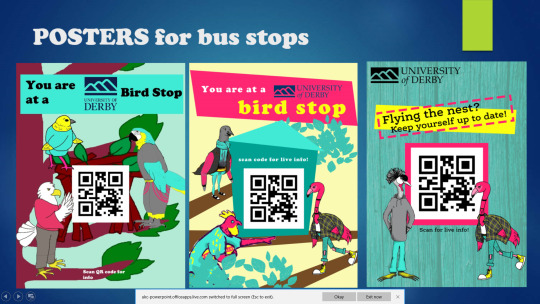
Continuing with the QR code AR idea from the pitch, we added the QR code onto our posters, which again once scanned with people’s phones would show live information for bus times, delays, etc. Mine on the far left is all my three characters on a tree, with the shelter housing the QR code a repurposed version of one of my original ideas for the bus stop. I chose to stick with a similar colour scheme as the characters, only more pastel. Another thing we wanted with the QR codes was to have the characters interact with people, as it is quite boring waiting around for a bus.
As mentioned previously, we wanted our characters to challenge stereotypes, and to represent diversity. Dimitry’s puffin, for example, is a punk rocker with bright hair, a contrast to the quiet and reserved creature you would expect, whereas Polly has made her flamingo casual and hipster, as opposed to snooty and upright. I have already explained about the Saffron Finch and the Eagle, but for my third and final character I decided to go with the Blue and Gold Macaw.

Macaws - and parrots in general - are normally quite loud, outgoing and brash birds, both in appearance and in personality. So I made my parrot quiet and thoughtful, opting to wear mostly grey and generally being in the background.
We achieved our aim of depicting Derby University as a hub for students (birds) from near and far, a welcoming place for people from all walks of life. With our characters, and designs for posters and the bus stops, we hope to allow students to access Derby travel information in a fun and engaging way.
Overall, I have really enjoyed working with my team. We all got along well, and there rarely any disagreements - if there were, they were quickly ironed out. We were all supportive of each other, and gave each other constructive criticism. The feedback I got for my characters helped improve them a lot. I loved working with people from the other courses, and we all hope to collaborate with each other in the future.
Conclusion:
How do you feel about this module, your practice and future ambitions? What is your action plan at this last point?
I feel that this module has been extremely helpful in terms of my future career. I have learnt more about networking, about post-graduate options, and about freelancing. I have met an artist I have admired for years, heard very good advice from fellow graduates, have started posting on Instagram to build up a profile of my work, both presently and from my previous years at University and schools. Whereas before I was still a little unsure about Illustration and considered doing fine art, I am now more confident about it - although I’m not going to rule out other fields at this point as I use many mediums. I have enjoyed working in a team and collaborating with people from other fields, working together towards a common goal. The Networking Event was one of the best parts of this module, and I will definitely be going to many more, once I’ve built up more of a portfolio.
Action Plan at this last point:
Find and book onto more art courses to build my portfolio- look up Green Door, and maybe some of Sandra Orme’s courses over the summer
Start entering more competitions
Start being more productive art-wise
Don’t be afraid to make mistakes
Make a list of other artists I would like to meet over summer
Talk to QUAD and Derby Museum about work experience
Find out about getting a part time job
Find out if there are any letter-press courses
Start building up a CV
0 notes
Text
Blog 11 - PGCE and Post-Graduate courses, plus the Networking Event
Today's session was about Post Graduate Studies, which fall under three categories: Taught, includes masters, Professional qualifications, and Research Studies.
Pros of Post Graduate Study:
You get more qualifications for jobs
You gain more experience and skills
Better pay in jobs
You gain more respect and get taken more seriously
Makes you stand out from others
You gain more knowledge, which is useful if you want to change your career at some point in the future
Cons of Post-Graduate Study:
Finding the money
Takes longer to get into industry
It was recommended that we look on Prospects for Post-Graduate Courses, and also to Tracy Tomlinson, who is the MA/MDes course leader. Also that we make sure that it is definitely something we want to do. A Masters Course is very intensive work, but the reward is worth it.
Several post-grad students came to talk to us:
Liv:
She did a BA and MDes in Illustration, and her preferred method is tradition types of print-making and inking. She likes animals and incorporates that into her work. She said at the end of the day, you have to make your own decision, and that it helps if you are passionate about what you do.
Marie:
She did the MDes from the beginning. It means she has the time to learn everything she needs to learn. The Careers and Employment services are very helpful.
Doing a Post-Graduate course is like a slingshot - it's taking an extra year to draw your stone back more so when it launches it goes further. You also get to network with a lot of people.
Some post-grads end up doing part time jobs - this can be helpful for job opportunities.
You don't have to have a set idea about what you want to do, and you might even find you want to do something else. However, you should have some ideas about your interests.
There is a lot of research involved, and also collaboration, especially in the first year as you're all in the same boat.
The Networking Event at the Sixty Seven Café
I managed to meet all the artists I'd put down on the form.
Pippa Pixley and Karen Logan
Pippa Pixley is a children’s picture book illustrator who works with schools, arts organisations, theatres and the BBC.
Karen Logan is an visual artist whose practice uses familiar materials and craft processes to invoke recollection and memories. Central to her work is engaged practice in galleries and schools.
Advice for Freelancers:
Look up illustration agencies and start finding work ASAP
Have an online portfolio, and send agencies 10 to 12 pieces of your best work
Show that you're interested in them, for example, talk about an illustrator they work with
Make your emails small and to the point, as agencies don't want to read a lot of text
Getting a rejection doesn't mean they don't like you, sometimes it's a way of seeing how committed you are (how many attempts you try)
Rejections are regular
Social Media is very important, but getting out there and meeting people is very important as well
Create your own opportunities - sometimes you just have to get out there
Be professional with everyone you meet - you never know who they might know
Have goals in mind
Follow trends
Have a digital portfolio, a physical card, and a sketchbook
Be yourself - practice in the mirror or video yourself to see what you look like
If you get nervous, take deep breaths or pour cold water on your wrists
Having anxiety isn't the end of the world as most people will understand
Rejection isn't personal, it's more whether they think your work first their MO
Pippa's Instagram
Adam Buss and Vikki Jones
Adam - The CEO of QUAD and founder of mainframe, a network for digital creatives, also the Summer Nights film festival.
Vikki - A freelance youth engagement specialist, focusing on getting young people involved with practical arts and cultural activities.
Advice:
When you start working in the industry, people expect you to be multiskilled
Keep inspiring yourself - go and use all those free galleries, theatre performances, exhibitions etc
A portfolio career - Vikki has several jobs (isn't necessary however)
Find the thing that you're good at and the thing that you like and try and combine the two
Don't beat yourself up for the things you haven't got, focus on the things you have
First jobs are very important and often teach you very important skills. Adam’s taught him about deadlines, managing budgets and organising events, and Vikki’s taught her about meeting other artists and designing.
Adam said that a third of the people QUAD hires are Derby Graduates - one of whom founded the monthly Japanese screenings at the QUAD, and now the Japanese foundation
Drew Taylor-Davis and Shannon Watson
Drew Taylor-Davis is Derby University Graduate who co-founded Future Proof Films with two of his friends to make visually engaging video content for companies and brands throughout the UK and the rest of the world.
Shannon Watson is a Content Producer at Crocstar - a creative content agency that works with organisations to create content. She wants to help creatives in the city.
Advice and about their work:
Sometimes you will get into something soon out of Uni - Shannon worked as an intern, before getting taken on part-time and then full-time
Drew did film studies at Uni, but wanted to get on with actually making films so formed the company with his friends
He got quite lucky in getting video gigs
If you're passionate about something, try and work in that
Drew collaborates with graphic designers for storyboards, and gets both graphic designers and animators to create animated elements to show clients
He says that he reaches out to companies, follows their social media, and sends messages - most won't reply, but it’s still important as you never know who they might know
The cons of having your own company is that it’s hard to switch off at the end of the day
The pros are 1; it’s quite cool to have your own workspace, and 2; it’s fun to be with other people and to have a shared goal
Networking is the best way to get a job as a freelancer
Some of [Drew’s] biggest clients include Microsoft
Again affirming that it’s about who you know as much as anything - Shannon’s personal trainer’s girlfriend landed her a gig
One of the questions asked was what was the most challenging aspect of your career:
Shannon has never been very confident, but you kind of have to get over that, as although it’s nerve-wracking the rewards are worth it. She had to teach something on her own and it was a learning experience.
Drew didn’t get paid properly for a while, and also stated that while confidence is very important, try not to oversell yourself.
Another important piece of advice is that it’s important to keep relationships with companies. However, if they don’t value your work or they don’t pay you properly, then it’s not worth it.
What I thought:
I honestly really enjoyed the Networking event, despite my initial nervousness at the idea. It was fun meeting a variety of artists, and all of the ones I met gave very good advice, which I will be taking on board.
Action Plan:
Research about any other upcoming networking events
Starting draw more, and sharing more of my work on Instagram (and cross post onto my art tumblr)
Talk to Tracy about swapping onto the MDes course, especially as I am not sure about the funding.
Follow more people -especially companies - on Instagram, Tumblr, and Facebook
Start being more productive and building up a portfolio
QUAD offers help with portfolios so possibly talk to them, as they have been helpful to me in the past
Be more positive and more self-confident about my work
0 notes
Text
Blog 10 - Team Project Continues
After much refinement, I managed to make my characters more bird-like, still sticking with the Saffron Finch and the Bald Eagle. As mentioned in Blog 8 we now have a fixed colour scheme - with allowances for shades - but I find that helpful as limited colours force you to think outside the box.
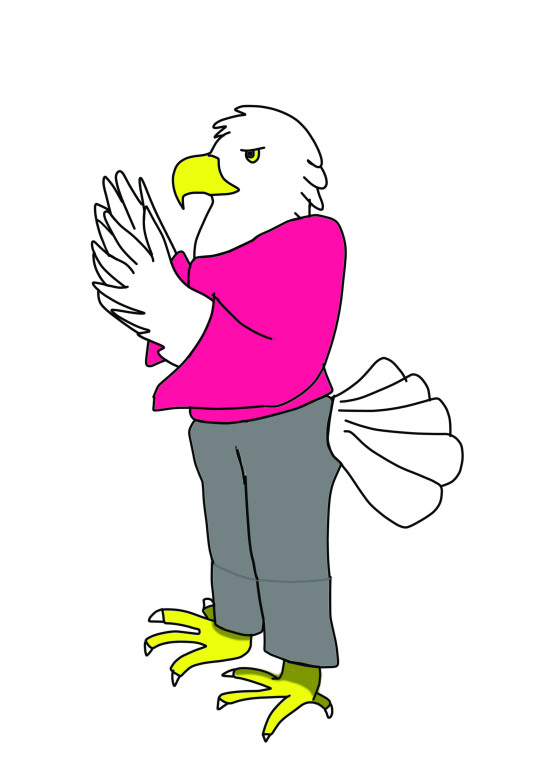
I initially didn't have a tail, but the feedback I got indicated that it would work better with a tail. Bald Eagles are normally mostly brown, but due to the colour palette I made him mostly white - which to be honest works better, and stands out against the magenta and grey more. He is still confident and tough, but again is still willing to help - hence the outstretched arms - and is not as stuff. I have dressed him in a loose fitting t-shirt and grey baggy trousers, making him more casual.
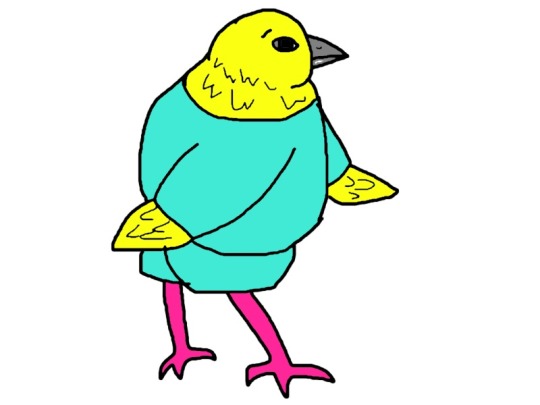
The saffron finch now also actually looks like a bird. Still small, but outgoing, not afraid to give her opinion or to boss her larger friend about.
We have decided, as a team, to try and design some more characters over Easter - not too many, about 1 more for each of us, and also to take photographs of bus stops not only around the other campuses but also around places like the train station. Our thinking is places where students typically frequent. Nathan, Polly, and I have also volunteered to design some of the posters that will be on the bus stops.
Action Plan:
To design more characters over Easter
Work on posters - possibly look at others
Possibly look at Beatrix Potter and other illustrators of andromorphic animals.
Possible Birds for new character:
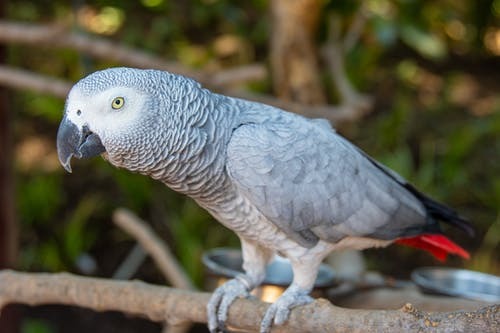

Parrot - either African Grey or Macaw. Typically very outgoing and take-no-shit birds, maybe have them in duller clothes and be reserved and quiet.

Rainbow Lorikeet (might be a bit difficult due to array of colours).
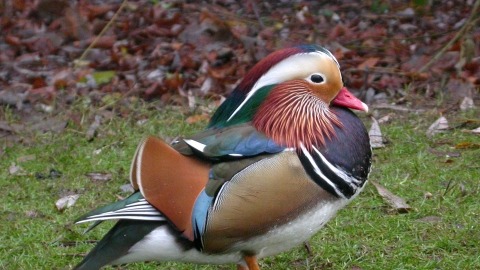
Mandarin Duck - might be an interesting challenge, also like the parrots, it adds another continent to my array of birds.
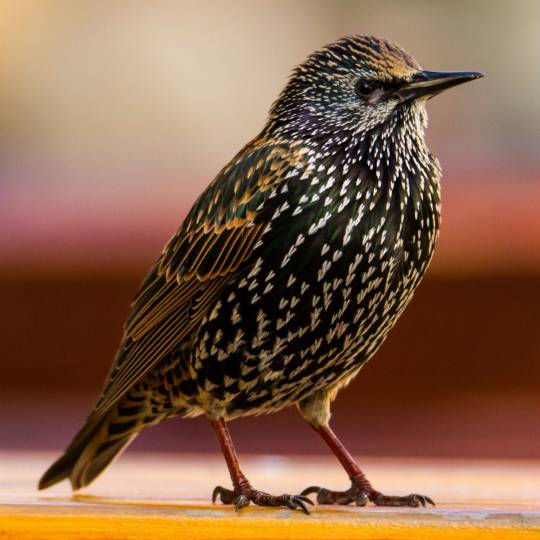
Starling

Magpie - would provide a great opportunity for some of the colourful clothes as it would stand out more. Also a good one for subversion - magpies tend to steal shiny things and are very noisy. Maybe an altruistic magpie who is very helpful.
0 notes
Text
Blog 9 - Self-Employment
This week was about working for yourself, and we were talked to by three people: Laura Williams, a commercial business services manager, Pandroa Johnson, a freelance illustrator for Applebox Designs, and Jodie Powell, a tattoo artist.
Many visual communicators end up doing private work, and there are many reasons why people freelance.
- picking up new skills
- Earns more and improves quality of life
-Sharpening existing skills
- Build my professional network
- Flexibility
- Keeping work exciting
- Being selective and job fulfilment
- Being in control of their destiny
Having a wide range of knowledge and skills helps - we all got post it notes and were told to put down what we thought were the most important.
Knowledge:
- Money Management,
- A talent for art
Skills:
- Time Management,
- Discipline,
- Flexibility to work in different mediums
- Passion and Creativity
- People Skills
- Ability to say no to briefs
- Adaptation
-Communication
You also need an Enterprising mindset as well. Being organised, innovative, resilient, commercially aware, and a problem solver are key. Especially commercially aware - it helps to know what the competition are doing.
They mentioned the Be the Boss programme, as well as talking to Careers and Employment. I will be looking at both later.
Laura Williams talked about Banks Mill, and how having a studio really helps.
Pandora Johnson is an illustrator and print maker, and is the founder of Green Door, an environmentally friendly print studio based in Derbyshire. She started out making websites for fellow creatives. Her advice to us was that it is okay to make mistakes.
Jodie Powell is a tattoo artist, who manages to make time for holidays.
Her advice was that, whatever you go into, you have to have the passion for it, otherwise it will get too much. You don't want to be stuck in a job you hate. Having passion will also help motivation (which has always been an issue of mine, so this is very important. She sets her own hours, and also said that you have to combine two things - what you enjoy doing, and how you could make money. Having a business plan is very important.
Action Plan:
Research more about self-employment.
Follow Jodie's advice - think about what I love doing art-wise and how I could make that commercially viable.
Stop worrying so much about mistakes
Look up Applebox designs
Research more about Be the Boss
Look up Green Door
Try and arrange something with Careers and Employment Services
0 notes
Text
Blog 8 - The Team Pitch!!!!
Over the past few weeks, we have been working hard for this project. We all designed (and in some cases animated), our characters. My original idea was for bird like human characters - unfortunately by the time I was told that the idea was more for birds dressed as humans rather than bird looking humans the pitch was too near. This is in part my fault as I did struggle with time management.
The birds that I chose were an Bald Eagle and a Saffron Finch - from North and South America respectively. I originally wanted to try and get birds for all 7 continents, but the team consensus was that everyone design only about 2 characters each.
We are going to have our bird characters flocking together at the bus stop.
Below are the sketches for the more human like birds.

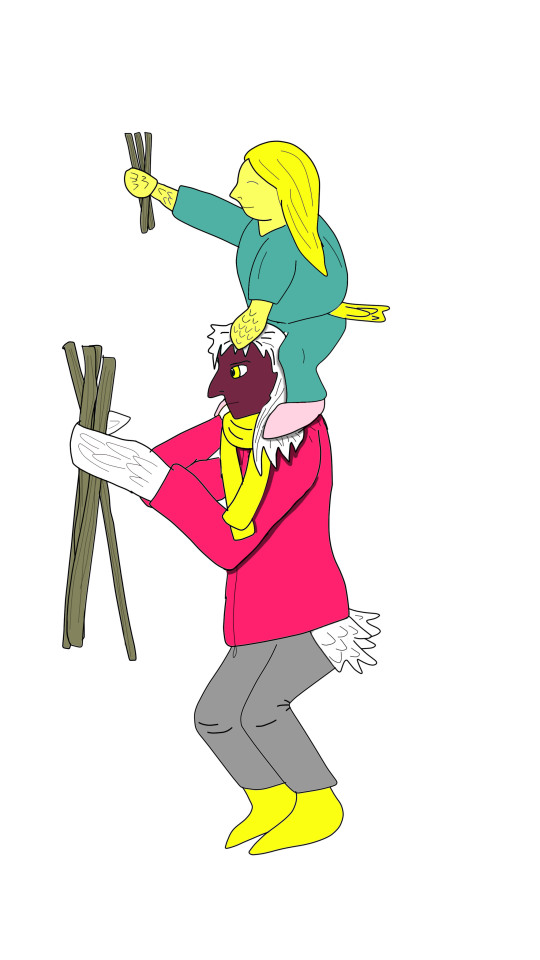
One of our original ideas was everyone helping each other. We were going to have the characters flocking together to build the bus stop, the show the community spirit. Hence why I have the small Saffron Finch on the shoulders of the larger Eagle, both with twigs in their hand. This also informed my bus stop idea, which was to have the shelter made of twigs, and the seats looking like leaves.
With our characters, we wanted to challenge stereotypes, so we designed our characters to be a subversion of how these birds would normally be perceived. For example, Polly did a slobbish, laid-back, and relaxed penguin, as opposed to the stuffy, formal, and serious bird you would expect them to be. The Saffron Finch is a small bird, one you would expect to be quiet and shy - instead, she is bold and outgoing, dressed in bright blue and giving orders. Eagles are normally associated with leadership and confidence, and although I have gone slightly more with that in mine, he is also willing to help his friends, and to work hard with others.
We all decided we would have a fixed palette, as not only would it make the characters stand out from the walls, it would also link all of our characters together.
All in all, the pitch went very well, so is unlikely to change much for the final presentation.
Action Plan:
Redesign both my characters to actually look like birds
Look at other bus stops - possibly Kedleston Road
Consider other birds to make into characters
Continue with team meetings
0 notes
Text
Blog 7 - Meeting Mair Perkins
The practicioner I chose to meet was Mair Perkins, a local freelance illustrator and animator who went to Derby University and chose to stay here. Having talked to her a few times on Facebook, and being a fan of her art, I felt that it would help if I met someone I at least sort of knew. Below is a summary of the answers she gave to my questions.
1. What are her current projects?
At the time of the interview, she was working on a project for a car leasing company on an Animatic Custom Computer. She is very organised, and has a calendar to keep up to date with her projects, and she had blocked out two months for her current one. She was using a computer with three curved screens, which is more immersive and helps with the process.
2. What is her process?
For animation, it starts with getting a brief and a script. She then works on the concept and the storyboards. Then the voiceover, and the animation production. The project then reviewed, and if it is satisfactory, delivered to the client.
3. Does she enjoy her work?
She doesn't always like her briefs, but at this stage in her career she can be choosier with what she takes on. It helps that she has built up a client base, and says that this is very important.
4. How do you balance work and home life, and do you get much time for personal projects?
She doesn't get much time for personal projects - when not working on a brief she normally works on her marketing. This includes working on her website, and on her social media like her Instagram. Having a studio helps the balance of work and home life, as well as with time management.
5. How did she get into freelancing?
She did animation at University, and ended up kind of falling into freelancing during the recession. Things were difficult job-wise, and she found that she like freelance better than conventional employment.
6. What are her inspirations?
A site called Wine After Coffee, which features many animation and graphic artists, and is an opportunity for them to showcase their work, especially their developmental work.
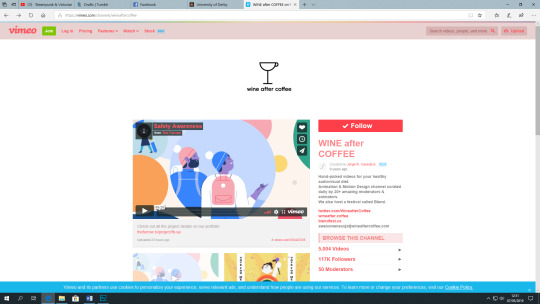
7. What made her get into illustration?
She did fine art in college, but found she didn't like it, and was told that she was better suited to Illustration. She did a BTEC, and did a combined Illustration and Animation course. She changed course the next year.
8. Why Illustration and not fine art?
Fine art is more to do with self expression, and she preferred to do fantasy art. Illustration and animation allows her more freedom in this.
9. Does she enter competitions?
She doesn't enter many competitions, but says they are very good for building up your CV and portfolio.
10. How is she for deadlines?
She always meets her deadlines, but admits that she was always a last minuter at Uni (obviously I related to this very much indeed).
11. Does she have any tips for time management?
Unplug the internet!!
12. What is her favourite part of her work?
Character animation, and rigging the parts separately. The characters are done in Adobe, and any illustration is done with a tablet (she recommends using a tablet).
13. Any other pieces of advice?
Drawing wise, tracing images is perfectly fine for practice. She also recommends doing life drawing courses, as they are extremely helpful for things like anatomy, scale and poses.
Overall, I thought that it went extremely well. Mair was very friendly and professional, answered all my questions, and did not mind that I was a bit nervous. The idea of freelancing has intrigued me, and I am interested to find out more about it.
Action Plan:
Research more about freelancing.
Have a proper look at Wine after Coffee.
Look up Illustration Post-Grad courses, as fine art does not sound quite my thing (like Mair I also like drawing fantasy and sci-fi art).
Find out what competitions I could enter in the future (especially on Zealous)
Find out ways to be more productive
Work out what other artists I'd like to meet (even if not for this module it could still be useful for the future)
0 notes
Text
Blog 6 - The Team Project!!!!!!!!
Our team consisted of six people - Nathan, Dimitry, Helena, Polly, Ofu and me. We almost immediately decided to use bird house as a way to show the diversity of University students. Our first meeting went very well; our aims were to establish the visual/narrative theme, agree on our roles in the group, and work out what we were going to research.
The overall agreement was that we were going to create a metaphor for student life, as students are in a sense migrating, flocking to Uni on this big journey. We discussed the idea of “Creative Nest” - University is a bird house where students bring in their ideas and engage with one another, like birds bringing food to their nests to share.
Visual ideas: The idea of pigeons was brought up, as they use the stars to navigate. We considered possibly using constellation in our work, and that maybe they could be map routes for students.
An enclosed space, so students are made to feel as though they are in a bird box. Holes around the walls could so things looking at us, giving a sense of intimidation to represent the pressures that students face.
One thing we agreed would be part of it no matter what was that we would show the diversity of students and cultures.
Action Plan for our next meeting:
Everyone is going to design/animate a character, background or texture for next week, for the theme of Creative Nest.
Research how Zappar (the VR site) works.
I have look up a few birds already, possibly getting a bird from each of the seven continents to show the diversity of students.
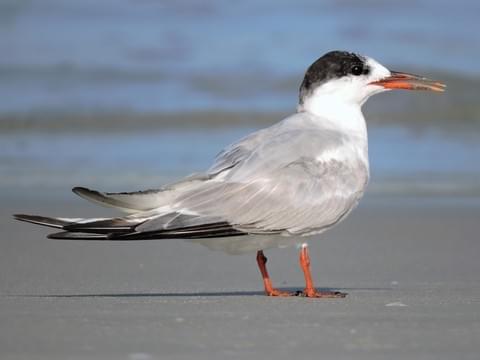
Arctic tern
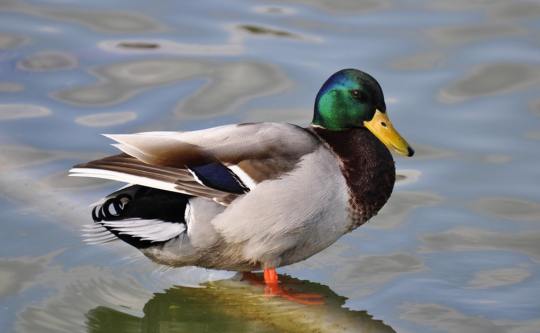
Duck

Emu

Penguin
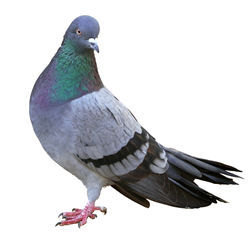
Pigeon

Robin
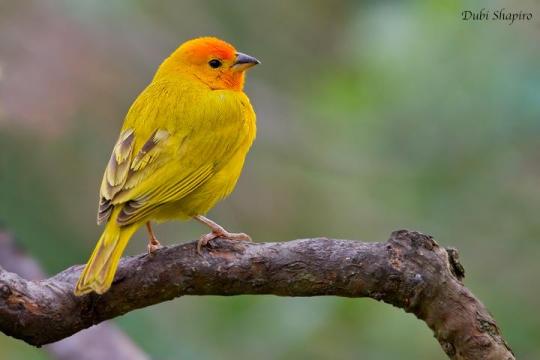
Saffron Finch
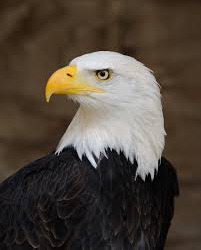
Bald Eagle
0 notes
Text
Week 5 - Visit to Manchester
I ended up not going to Manchester because I was ill. So instead, I have decided to talk about QUAD Young Advocates.
QUAD has two main groups for young people - Young Creatives and Young Advocates. The latter is a group for 16-25 year olds, a chance to learn organisation and working together as a team. They help curate exhibitions, organise workshops and events, and help with film festivals. Their page is here.
I myself have been a member for about three years. I saw it as an opportunity not only to build my skillset, but to meet new people, and to get more involved with creative projects. I have helped with two FORMAT Photography festivals, a Silent Disco, and a film festival. We plan these events over several months, and it is always interesting hearing everyone's views and debating over things. We work with artists and staff to create these events. Some are more successful than others, and after each event is finished we discuss what went well, what didn't, and what we could do better next time.
I am only focusing on two of the events I have helped with -the Silent Disco and the Film Festival. The Silent Disco was an idea suggested by the team leader, who had been to several, but most of us had never heard of one before. We decided that the theme would be heroes and villains, and that there would be two separate related soundtracks for people to listen to. We went through several songs, decided to have drinks based off pop culture, and also decided that there should a fancy dress competition.
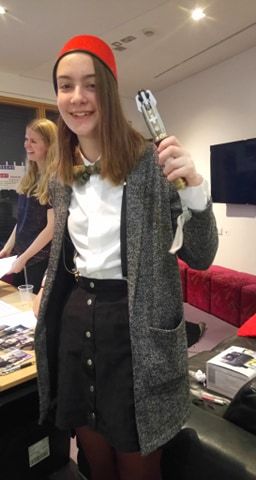
It did not go well, however. Only about seven people turned up, and although we tried our best we didn't get a whole lot of help with the marketing. In the meeting afterward we agreed that although interesting, the idea of a silent disco was far too niche for most people of our generation. It was agreed that next time we would go with a regular disco and try and advertise more in schools and universities.
The film festival went better. The theme we went with was Best Worst Film, and we spent several sessions looking through some of the best worst films of the best decade or so. We eventually voted on Sharknado (an absolutely terrible made-for-TV movie on the SyFy channel).
The marketing went better - we all got shark masks and took photos of us doing stuff with them on.
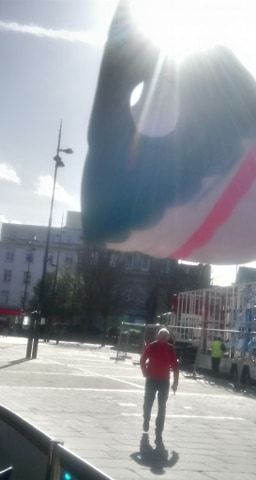
We also decided to up the decorations of this film festivals. I helped paint waves that went along the staircase, as well as make a photo-booth in the shark of a shark's head (this is visible on the Young Advocates page on the QUAD website). We also decided to go again with the fancy dress, based around Sharknado - so things like sharks, lifeguards, beach-goers etc.
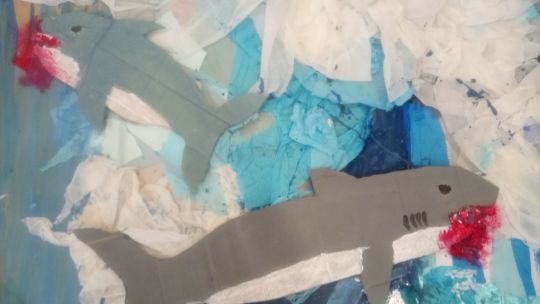

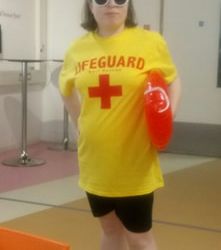
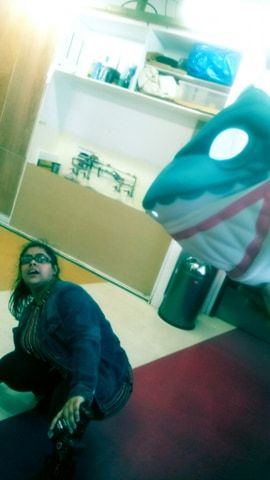
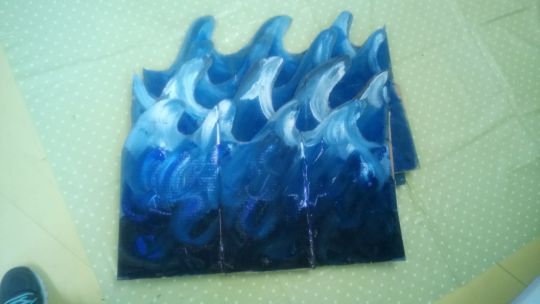
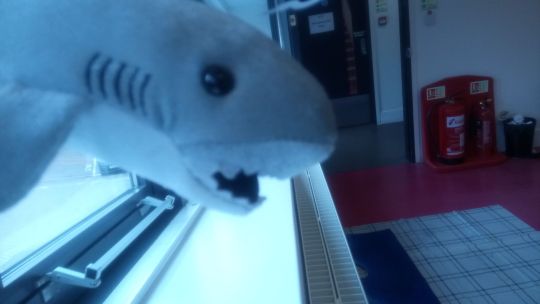

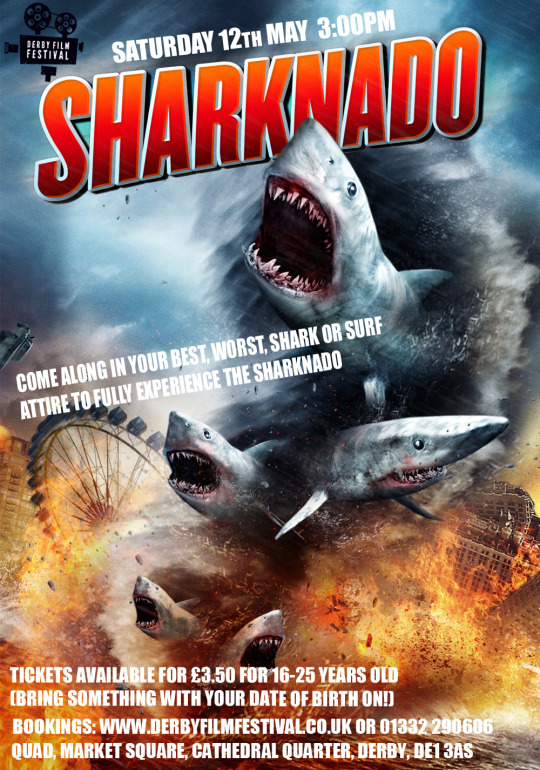
This event went better, even though we didn't make a profit with ticket sales. But people turned up, in costume, and we all had a lot of fun, especially has we'd gotten inflatable sharks to throw around when the Sharknado parts happened in the movie.
I chose to talk about this group because I feel it has been very beneficial to me. It has taught me how much work goes into organising creative events, about marketing, budgeting, and team work, all very important things for artists to know. Some work is more interesting than others, like the Photography festivals, but even when it isn't really to do with art you still learn a lot, and our failures help to inform any future events that we do.
0 notes
Text
Week 4 - The Three Artists
The first guest lecturer was Korky Paul, a teacher of Illustration at Oxford, and who also illustrates children’s books. It was interesting hearing about his learning process. One thing that his mentor taught him was the task of matching different fonts to different people. He also learnt to sketch out ideas very quickly. He always takes photos of his work – which is something I perhaps should do more frequently. He gave several pieces of advice. One was that if you work on children’s stories, never tell the author they have too many words – tell their publisher instead.
His art process starts with him getting a grid – he prints about 20 to save time – for the pages. You also always have to consider the words, and where they are gonna go – don’t forget about the text. He makes a rough drawing, blows it up, and then sticks them together.
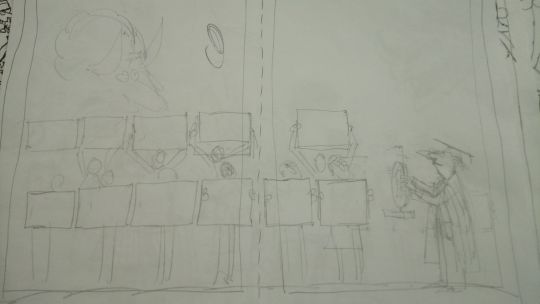
Light boxes are very hand – preferably A2. They cost around £70, but it saves time. He recommends rather than looking at other people’s work, research actual photographs of, say, animals – research is very important in this field. He explains that you don’t have to follow the tracing exactly, and they’re more of a guide. His preferred equipment for the inking is dip pens.
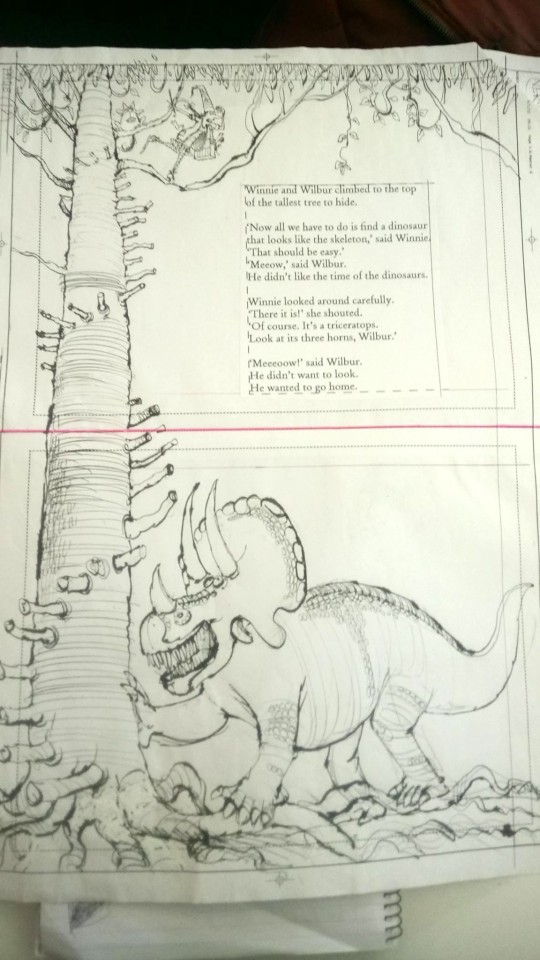

Another good piece of advice is that when rubbing the pencil lines out, use a make-up brush to brush away the debris, as fingers are oily and will smudge the drawing. For the drawings, making them around 5mm bigger, as the guillotine will leave a line otherwise. He uses Windsor and Newton Art Masking Fluid, and for the actual colouring uses watercolours. The background comes first, then you continue the scene forward. He also uses Acrylic Liquid for Airbrush, and colourex inks. He says that you shouldn’t spend a lot of time on the sketches and to focus more on the actual drawings. He also never changes the colours on photoshop. He has always worked on cartoons.
The second was Ian Cherry, Graphic Design and Brand Manager for Derby County Football Club (DCFC), a former student of Derby University. His job involves working on all aspects of design and branding. His college didn't do Graphic Design, but he stuck with it and eventually applied to Derby University, being accepted in 2009, and stayed for 3 years. He tended to go for nights out, but somehow managed to get his finals done.
His first job was for a company called Sporting ID. They did the add-ons for clothing. This was used by several big partners and international bases - his job was Design Assistant, and he helped with the marketing. He gave several pieces of advice on how he got the job.
- He was positive
- He did his research on the company and interviewers
- Had a portfolio in which he only showed his most relevant work.
He got promoted because he was able to recruit a Junior Graphic Designer, before further being promoted to Graphic Designer and Brand Manager after recruiting yet another designer. He says there is no such thing as a typical week, and that it depends very much on the team's success. He has no particular designer as an influence, but instead goes for other sources. For example, the typefaces on menus, things he sees on TV, social media, and just driving around. They get a brief, create a concept, then pitch to their client. It can be very tedious but they manage to get through it.
He looks out for several key things in Graduates
- A good Cover Letter
- A good CV
- A good portfolio
- Being comfortable talking about and justifying their ideas
- Keen to learn
- A core set of skills
He also gave three other pieces of advice, to take every opportunity, as he never expected to become brand manager. Don't be afraid to fail!!! And make something of everything!!
We also met one of his junior designers, Nick Raven, who also gave advice on when he was looking for jobs. He looked at the job description, shows examples of his work, does research on his projects. He also admitted to sometimes being personally motivated. He was always very honest and open.
In his first few weeks, he learned more about his role and travelled a lot. His toughest moment was when, a few weeks into his job, his father died, which he said was an example of how life can derail your career. He went back to the job because he knew that's what everyone would want. He advised developing a thick skin, as some people will hate your design. He was promoted to Graphic Designer and has done work for several big club. He explained that you do obviously have to deal with disappointment, that sometimes he has failed to pitch his ideas, or they simply preferred someone elses.
Sam Moore, was the animator, who recommended that you apply for competitions. She is a documentary animator. Again, she said that research was very important, and that rejection can be good as you can learn from it. Also, if you want to collaborate, always ask. Some people will ask you to collaborate with them. She teaches two days a week.
Her earliest work was on glass. A third of her time as an animator is spent securing funding. Some of her work can take years to complete, as Animation is a very time-consuming job. She said being a mother helps with the time management aspect.
One thing all three artists had in common was the sheer amount of time it takes to work on these projects. Also that whilst it is disheartening, rejection can actually be useful, and that it often isn't personal, it is just that you're either not right for them, or they preferred someone else's.
The one I enjoyed most was Korky Paul. Partly because he is also in Illustration, and because illustration of children's books was one of the reasons I did this course. But I also enjoyed hearing about his process, and I thought his advice was really helpful. Learning about the CV and Portfolio from Ian was also helpful, though, especially the part about their most relevant work for whatever project they are hoping to be commissioned for.
Action Plan:
Buy a make-up brush, and look into getting a lightbox
Post more on Instagram, and look into ways to build up my profile in general
Start working on my CV and portfolio, as well as looking into courses to do over summer to help build up both.
0 notes
Text
Week 3 - Future Career
This week we were looking at possible career options, and we used the job site Prospects, to see what sort of jobs there are out there for us. The main thing we were looking at was a page called “What Can I do with My Degree?”
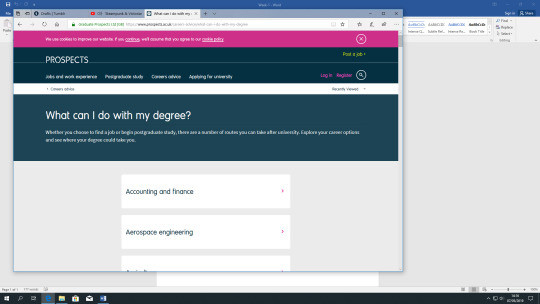
As I’m an Illustration student, I decided that for this blog I would focus on what, exactly, an Illustrator could do.
Copy and Pasted from Prospects
You will need to be determined if you want to succeed in freelance illustration, but this applied art form opens up opportunities across a range of media and visual communications platforms
Job options
Jobs directly related to your degree include:
Animator
Graphic designer
Illustrator
Multimedia programmer
Printmaker
Production designer, theatre/television/film
Jobs where your degree would be useful include:
Advertising account executive
Arts administrator
Artworker
Fashion designer
Fine artist
Higher education lecturer
Textile designer
VFX artist
Web designer
I chose to look at three of these: Illustrator, Printmaker, and Fine Artist. I am not going to go into absolutely everything, but give a basic overview of what each job is about.
Illustrator:
Typically commissioned to create still drawings and images to create an idea. These can be used for various things, from advertisements and books, to magazines, packaging, and greeting cards.
Illustrators will tend to specialise in a particular design medium, such as drawing, photography or digital illustration.
Types of Illustrator:
Work is predominantly freelance, with most illustrators being self-employed. Areas of work include:
advertising - advertising posters, storyboards, press
publishing- books
corporate work - brochures, catalogues
editorial - magazines, newspapers and comics
fashion - forecasting
merchandising - greetings cards, calendars, t-shirts, ceramics, etc
multimedia - TV, film, computer games, websites, apps, animation.
There are a lot of responsibilities involved. An illustrator works with clients, negotiates pricing and deadline, creating images and designs in traditional hand-drawn methods, providing rough sketches for approval, running the business if working freelance and many more.
Skills:
the ability to market your skills
professionalism
imagination
knowledge of computer-aided design (CAD) techniques and printing processes, including computer graphics
research skills.
Printmaker:
This caught my eye as I enjoy printmaking somewhat , and wondered what exactly this entailed.
They use techniques such as etching, lithography and print-making to create images on surfaces. You’ll tend to design the prints yourself, normally onto a variety of surfaces. This is normally used for promotional items like t-shirts and signs, and silk screen printing for posters.
Skills:
the ability to find creative ways of producing work that will meet client specifications
a good understanding of the properties of the different materials used for printing
dexterity, to handle a range of printmaking equipment
strong communication skills
the ability to set and achieve goals
networking skills to build and develop relationships, for successful self-employment.
I’m not too sure about this as a career option myself, but I thought it worth it to research into it.
Fine Artist:
Back in Year Zero I considered doing this before ultimately choosing Illustration. It still interests me as a possible career, however.
Fine artists create a lot of work in a variety of media, making 2D, 3D and 4D (Moving Images and Performance FYI) work. They tend to specialise. They are either commissioned or create their own pieces of work.
They have rather a lot of responsibilities, mainly generating ideas, developing their work, sourcing materials, management tax and any self employment issues, applying for residencies and competitions, negotiating sales and commissions, and many more.
They tend to fund their career either through a full or part time job. The majority of exhibition spaces are normally within London, Newcastle and Manchester. It does warn that flow of work tends to be irregular.
Skills:
determination and commitment
self-belief
idea development
good visual communication skills
business and self-promotion skills
technical ability
good verbal communication skills
organisation skills and the ability to meet deadlines
research skills
ability to work independently and with others
stamina and a willingness to put in long hours.
All three of these mention that it tends to mean a lot of long hours, and that you won’t always get a lot of work.
One key organisation in this field is the Association of Illustrators (AOI). An opportunity to showcase your work, as well as offering help with portfolios.
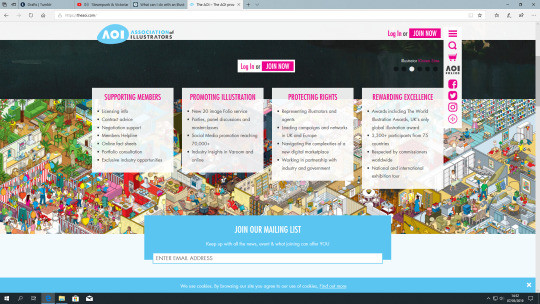
There are many awards in this field. One which the AOI is associated with is the World Illustration Awards, a competition which has run for over 40 years. Entries can be made into one of 8 categories, which represent the work being commissioned today.

Action Plan:
Join the AOI, find some other sites, start entering competitions more. Also consider looking at studios for future reference, as it would be nice to have my own space. Also keep an eye on opportunities on Zealous. I might also talk to careers about what I could do after University.
0 notes
Text
Week 2 - Networking
Week 2 was all about networking, about building up contacts and learning about how to get out there and make ourselves known as artists.
There are several artists I would like to meet. Chloe Yelland is one of my favourites, and is the reason I am doing Illustration at University. With Mair Perkins I have the slight advantage of having spoken to her on Facebook before, so that should help a little.
In order to boost my profile, it seems the best path is to start making more professional social media profiles. I will be making a new Facebook profile, and start uploading my art on there, as well as using my repurposed Year Zero University blog for my own artwork and illustrations.
I haven’t done a whole lot for my Facebook page but I have followed two artists I admire - Mair Perkins and @zandraart . I will be uploading my own art onto there also, as well as my brand new Instagram page - it was recommended to have a profile on there. Both will be great ways to boost my own art.
In terms of uploading my art, I feel that Instagram and my main art tumblr will be the best course of action, as they both are naturally more creative outlets - and, unlike Facebook, show their posts in chronological order. My Instagram username is starqueenoftheliberator - I will be uploading old artwork. I have a couple of ideas for posts: Snaps From My Sketchbook, showing development work from my many, many sketchbooks, Throwback Thursdays, showcasing my old University work, and Glimpses of the World, which will be my photography. I will also be cross posting with my main art blog on Tumblr.
I will also be looking for more opportunities to share my artwork. A consideration I had was using my art app on my 3DS to enter the Weekly Competitions on it, but sadly they concluded in August. But several of our projects in University are for competitions, and I plan to do more of this in my own time, to showcase my work and get my name out there. My new Facebook profile will be used more for the business side of things once I start setting up - this might not happen for a while yet. For Being Human, I had to join Zealous to submit my artwork - it seems that I will be able to build up a portfolio there, which will be extremely helpful.
There is a Design Networking event in April, which I will be going along to along with several of my classmates. I will make an effort to talk to people.
1 note
·
View note
Text
Week 1 - About me
I am creative, hard-working, and friendly with other people once I get to know them. I enjoy working in teams and collaborating with other people. I am good at both hand-drawn and digital work, and try to work with limited colours.
I have always been interested in art - I did Art and Design for GCSE and chose Graphics as one of the three subjects in college. Although I enjoyed many of the tasks in Graphics, I felt that it was not the career path for me.
I first got interested in Illustration during The Big Show of 2015, where I saw Chloe Yelland's work on her children's stories. I thought her work was absolutely amazing, and I decided that that was what I wanted to do. Later, I chose to do Year Zero first, as I wanted to try various art mediums, and for a while I considered doing fine art before finally settling on Illustration. I loved the idea of telling a narrative, and the various ways to do illustration - for example, using Photoshop, or Screen Printing, or Laser Cutting.
One of my favourite mediums is charcoal. Those I consider my best pieces of art have been done in charcoal, and sometimes pastel.
One aspect I have started to do recently is Political Art. I have strong political views, and love satirical cartoons that you get in newspapers, so I decided to start doing that.
Many artists and animators are of great inspiration to me. Studio Gibli is one of my favourite film studios - their animation is sublime and their films are (most of the time), heart-warming, and carry strong messages of love and family and friendship. They are always a joy to watch, and for many years I have tended towards manga style art for characters.
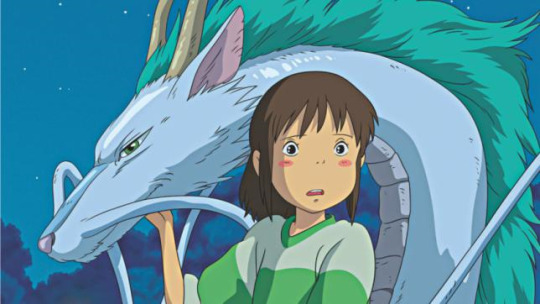

I would love to improve my scenery skills, as well as making my characters flow more like Studio Gibli.
Rainbow Rowell - an author and graphic novelist whose illustrations are fun, concise, and give a great sense of her characters.
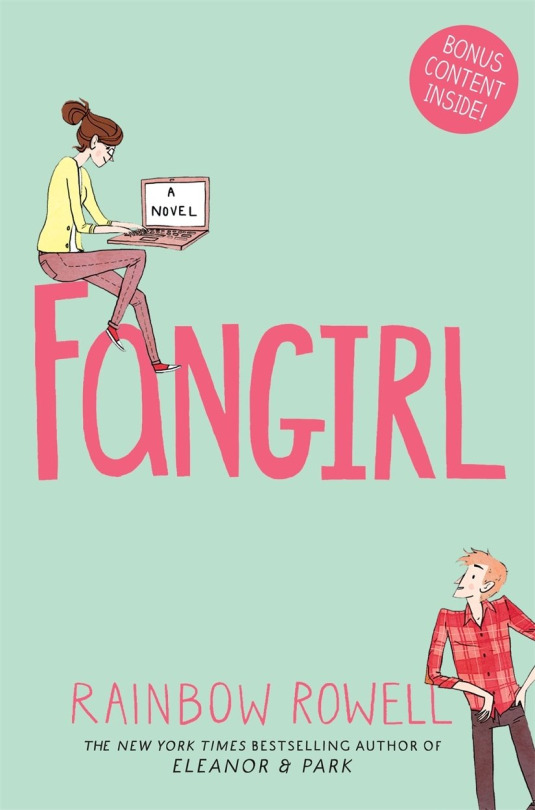
Simone Lia - a cartoonist in the Observer who always does hilarious and relatable cartoons.

Above - most people do this, I suspect. Procrastination is a very big problem.

Not a good idea - AKA Self diagnosis via Google doesn't actually lead anywhere

A personal favourite of mine, as I find it very heartwarming.
Personality test - Mediator Personality (INFP, -A/-T)
(Below, page one from my personality test results)
Mediator personalities are true idealists, always looking for the hint of good in even the worst of people and events, searching for ways to make things better. While they may be perceived as calm, reserved, or even shy, Mediators have an inner flame and passion that can truly shine. Comprising just 4% of the population, the risk of feeling misunderstood is unfortunately high for the Mediator personality type – but when they find like-minded people to spend their time with, the harmony they feel will be a fountain of joy and inspiration.
Being a part of the Diplomat Role group, Mediators are guided by their principles, rather than by logic (Analysts), excitement (Explorers), or practicality (Sentinels). When deciding how to move forward, they will look to honor, beauty, morality and virtue – Mediators are led by the purity of their intent, not rewards and punishments. People who share the Mediator personality type are proud of this quality, and rightly so, but not everyone understands the drive behind these feelings, and it can lead to isolation.
All that is gold does not glitter; not all those who wander are lost; the old that is strong does not wither; deep roots are not reached by the frost.
J. R. R. Tolkien
We Know What We Are, but Know Not What We May Be
At their best, these qualities enable Mediators to communicate deeply with others, easily speaking in metaphors and parables, and understanding and creating symbols to share their ideas. Fantasy worlds in particular fascinate Mediators, more than any other personality type. The strength of their visionary communication style lends itself well to creative works, and it comes as no surprise that many famous Mediators are poets, writers and actors. Understanding themselves and their place in the world is important to Mediators, and they explore these ideas by projecting themselves into their work.
Mediators have a talent for self-expression, revealing their beauty and their secrets through metaphors and fictional characters.
Mediators’ ability with language doesn’t stop with their native tongue, either – as with most people who share the Diplomat personality types, they are considered gifted when it comes to learning a second (or third!) language. Their gift for communication also lends itself well to Mediators’ desire for harmony, a recurring theme with Diplomats, and helps them to move forward as they find their calling.
Listen to Many People, but Talk to Few
Unlike their Extraverted cousins though, Mediators will focus their attention on just a few people, a single worthy cause – spread too thinly, they’ll run out of energy, and even become dejected and overwhelmed by all the bad in the world that they can’t fix. This is a sad sight for Mediators’ friends, who will come to depend on their rosy outlook.
If they are not careful, Mediators can lose themselves in their quest for good and neglect the day-to-day upkeep that life demands. Mediators often drift into deep thought, enjoying contemplating the hypothetical and the philosophical more than any other personality type. Left unchecked, Mediators may start to lose touch, withdrawing into “hermit mode”, and it can take a great deal of energy from their friends or partner to bring them back to the real world.
Luckily, like the flowers in spring, Mediator’s affection, creativity, altruism and idealism will always come back, rewarding them and those they love perhaps not with logic and utility, but with a world view that inspires compassion, kindness and beauty wherever they go.
3 notes
·
View notes